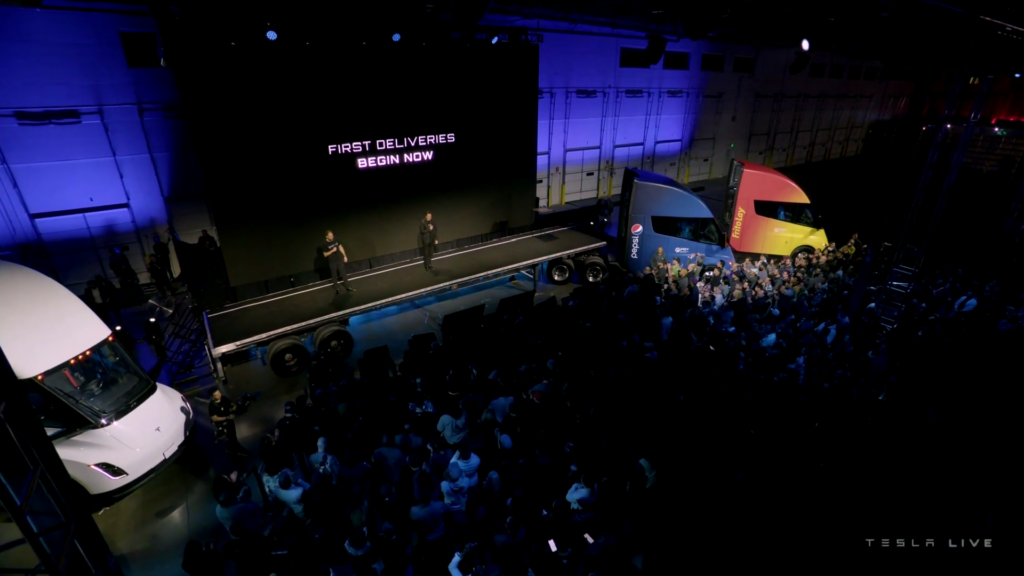Tesla delivers first Semi
Tesla delivered its first Semi last week, during a splashy event at its Sparks Gigafactory in Nevada. PepsiCo took delivery of the first unit on Nov. 30, then drove it straight back to the Gigafactory full of FritoLay snacks and beverages for the launch event held in front of Tesla employees and customers.
The event was livestreamed on Twitter, the social media platform recently purchased by Tesla founder Elon Musk.

“I can’t believe it’s been five years [since the Semi’s launch],” Musk said. “There’s been a lot that’s happened since then, to say the least. I’m incredibly excited tonight to deliver our first production Tesla Semi trucks.”
“We’ve been working on it in the background. We’ve made a lot of progress,” added head engineer Dan Priestley. “At the end of the day, we have not wavered from our mission to build the most compelling, greatest Class 8 truck in history.”
Musk said producing a heavy truck is part of Tesla’s grander vision of advancing sustainable energy and slashing road transport emissions. While commercial trucks represent 1% of the U.S. vehicle population, they contribute 20% of vehicle emissions and a third of particulate matter.
“That is why we’re doing it,” he said.
The delivery comes on the heels of an announcement that Telsa completed a 500-mile run on a single charge, grossing nearly 82,000 lb. The route went from Fremont, Calif., to San Diego, and Musk promised it was a stock unit with no trickery or aftermarket aerodynamic effects installed. Musk said the eight-hour video will be posted unedited to YouTube.
“Some people out there say it can’t be done,” Musk said of the range. “We just did it.”
“This is real world,” Priestley added, noting there was traffic and other variables to contend with on the drive.

While technical spec’s, price, support plans and other key details were not addressed, Musk said the truck is “kickass” for drivers and fun to drive.
“It looks sick,” said Musk. “You want to drive that. It looks like it came from the future. It’s like driving a Tesla [car]. There’s a shortage of drivers. If you’re a truck driver you want the most badass rig on the road. This is it.”
The truck is bullet-shaped for optimum aerodynamics and has three axle-mounted motors that engage and disengage as needed to provide acceleration and cruising. It brings technologies developed for Tesla cars to the Semi’s much larger package.
“This thing has crazy power relative to a diesel truck,” said Musk. “It looks like an elephant moving like a cheetah. It’s fast to accelerate, fast to brake. It’s really a step change improvement in what it’s like to drive a semi truck.”
Priestley added the Semi has three times the power of any currently available diesel truck thanks to its 1,000-volt powertrain. Three small electric motors – each about the size of a football – provide that power.
“You can check it in your luggage,” Priestley said of the electric motors. “Good luck doing that with a diesel engine. And one of those is more powerful than a diesel.”

Musk acknowledged reliability is key for commercial fleet operators, and said the Semi has been well tested in a variety of conditions including snow and cold. Tesla itself will be one of its early users.
“We’re going to take these and put our money where our mouth is and put them in our own fleet,” said Musk, adding the trucks will haul parts between suppliers and Tesla’s Gigafactory. “This will close the feedback loop. We will take all that data coming in and continue to refine the product and make it better just like we do on the car side.”
On its recent 500-mile run, Priestley said the Semi outpulled diesel trucks on the 6% Donner Pass, which it was able to accelerate up while traditional trucks struggled. “Any grade, you can tackle at speed,” said Priestley.
He added the regenerative braking also improves safety on downhill grades and eliminates overheating brakes or the risk of missing a gear. The driver stopped at a mandatory brake check pull-off at the bottom of Donner Pass and reported the wheel-ends were cool.
The truck was also designed for driver efficiency. The driver’s seat is mounted in the center of the cab. The high roof allows a driver to comfortably stand up inside.
“That level of space is unheard of and we were able to do that with pretty innovative packaging,” Priestley said of the interior.
PepsiCo ordered 100 of the trucks in 2017 and the first will be deployed transporting loads from its Frito-Lay plant in Modesto, Calif., and its beverage factory in Sacramento.
The handoff ceremony can be viewed here:
Have your say
This is a moderated forum. Comments will no longer be published unless they are accompanied by a first and last name and a verifiable email address. (Today's Trucking will not publish or share the email address.) Profane language and content deemed to be libelous, racist, or threatening in nature will not be published under any circumstances.
I would love to sport one of these electric semi trucks around been driving semi’s for year’s
FLAT LAND, WARM WEATHER, STRAIGHT ROAD , NO MAJOR HILL , VERY LITTLE TRAFFIC, WAS IT DAY OR NITE OR COMBINATION OF BOTH